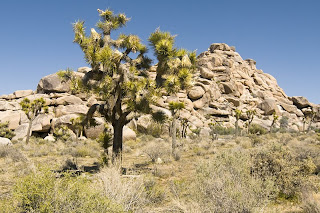What I expected from Joshua Tree National Park was a desert landscape populated by the somewhat odd Joshua Tree, where one could drive through several miles of improved roads and marvel at the number of these trees in one location. What I got was a lesson in geology.
 Coming in from the south, the first thing that jumps out at you is that Joshua Tree National Park is totally devoid of any Joshua Trees. The Visitor Center has a large helpful sign that explains that there really are Joshua Trees in the park, they are just further north. What this area does have is some lovely desert scenery with patches of ocotillo and cholla. The ocotillo, a desert plant with long, spikey "leaves" extending upward for 8 feet or so, was infrequent on this drive. However, the cholla garden, a huge area where the cholla have all but taken over the desert, was amazing. The photo on the left shows a cactus in bloom in front of a small part of the garden.
Coming in from the south, the first thing that jumps out at you is that Joshua Tree National Park is totally devoid of any Joshua Trees. The Visitor Center has a large helpful sign that explains that there really are Joshua Trees in the park, they are just further north. What this area does have is some lovely desert scenery with patches of ocotillo and cholla. The ocotillo, a desert plant with long, spikey "leaves" extending upward for 8 feet or so, was infrequent on this drive. However, the cholla garden, a huge area where the cholla have all but taken over the desert, was amazing. The photo on the left shows a cactus in bloom in front of a small part of the garden.
 As we moved north, we passed from the Sonoran Desert into the Mojave Desert -- a transition that might, at first guess, seem to be much ado about nothing. But the vegetation was somewhat different, and we began to see more rounded piles of rocks and, at last, Joshua Tree forests. The rounded piles of rock turn out to have a very interesting geological explanation. They formed eons ago as magma-filled underground chambers. As it cooled, vertical and horizontal cracks formed. As the ages wore on and the topsoil eroded, the rocks were exposed to weathering in a climate that was wetter than today. As an ice cube held under water will first become rounded, so have the edges of the cracks become rounded, resulting in many sphere-like boulders still contained in the original shape of the mound.
As we moved north, we passed from the Sonoran Desert into the Mojave Desert -- a transition that might, at first guess, seem to be much ado about nothing. But the vegetation was somewhat different, and we began to see more rounded piles of rocks and, at last, Joshua Tree forests. The rounded piles of rock turn out to have a very interesting geological explanation. They formed eons ago as magma-filled underground chambers. As it cooled, vertical and horizontal cracks formed. As the ages wore on and the topsoil eroded, the rocks were exposed to weathering in a climate that was wetter than today. As an ice cube held under water will first become rounded, so have the edges of the cracks become rounded, resulting in many sphere-like boulders still contained in the original shape of the mound.
 The topsoil now has totally eroded and, over time, exposed the magma chamber to our view. The edges of what was the chamber are dark rock while what was the magma -- technically called monzogranite -- is light. On some hills, you can actually see the edge of the magma chamber with some monzogranite still clinging. Look beyond the Joshua Trees in this photo -- the white rocks on the far hill are the monzogranite, while the hills themselves are all that is left of the then-underground magma chamber walls.
The topsoil now has totally eroded and, over time, exposed the magma chamber to our view. The edges of what was the chamber are dark rock while what was the magma -- technically called monzogranite -- is light. On some hills, you can actually see the edge of the magma chamber with some monzogranite still clinging. Look beyond the Joshua Trees in this photo -- the white rocks on the far hill are the monzogranite, while the hills themselves are all that is left of the then-underground magma chamber walls.
There are also lovely views of the Coachella Valley from the park. This valley is part of the tectonic plate boundary that includes the San Andreas Fault, the Salton Sea, and the Sea of Cortez -- and which will be, millions of years from now, a new ocean as the plates' junctions beneath the valley continue to expand. In this photo, the Salton Sea is just visible as a light streak on the far right:


No comments:
Post a Comment